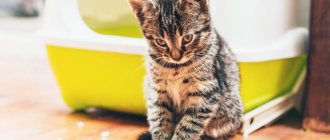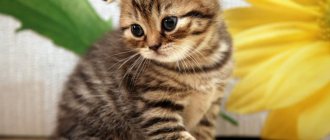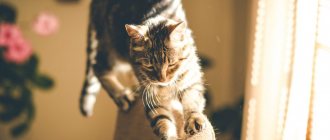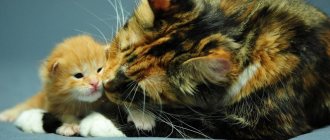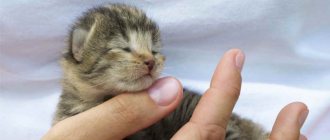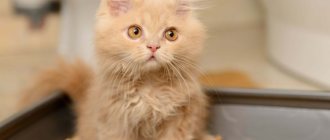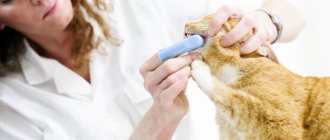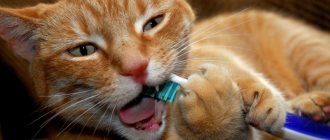Pets often suffer from problems with the digestive system. Often the owner himself is to blame for this, neglecting to properly feed the animal. Fecal retention is fraught with acute intoxication and possible damage to the intestinal walls. To prevent unpleasant consequences, a responsible owner needs to know what to do if his cat becomes constipated.
What can be considered constipation?
Constipation in a cat is a prolonged delay in defecation, making it difficult to completely or at least partially empty the intestines. To identify the problem, count how many times a day your pet visits the litter box. The norm for adult animals is 1 time per day, for older animals – 1 time every two days, for kittens – 2 times per day. The frequency of bowel movements depends on the metabolic rate. The younger the animal, the faster its metabolic processes.
Separately, it is worth considering the feces themselves. In a healthy cat, they should be oblong, soft and dark brown. A change in shape, consistency and color is a reason to contact a veterinary clinic.
Causes
Constipation in a kitten occurs under the influence of the following factors:
- Blockage of the intestine by helminths and foreign objects.
- Lack of fluid when feeding dry food.
- Overfeeding.
- Eating spoiled foods.
- Digestive disorders.
Some fellinologists, who have knowledge of how to help an adult with constipation, try unsuccessfully to transfer such techniques to a small kitten. They recommend a paste for removing trichobezoars; they assume that the baby lies on the sofa all the time, suffering from adynamia, or has developed postoperative constipation. An attempt to eliminate stool retention in a kitten using methods applicable to an adult animal can lead to dire consequences.
recommended articles:
- Nephritis in cats
- How to treat glomerulonephritis in cats?
Signs of constipation are few and can be detected by the pet owner. Among them are:
- Screaming in pain while trying to have a bowel movement.
- Lethargy, apathy, loss of appetite.
- The abdomen is swollen and painful.
- If an increased heart rate, shortness of breath and fever are observed, the kitten has an obstruction of the intestinal tube. Immediate veterinary attention is required.
Reasons for lack of stool
Lack of stool is only a symptom, not a disease. Before starting treatment, you need to understand what the root cause is. Defecation delay occurs when:
- foreign body entering the digestive tract;
- neoplasms or accumulation of hairballs in the intestines, that is, obstruction;
- stress associated with moving, separation from mother or the appearance of new family members;
- inflammation in the anal glands or rectum, accompanied by acute pain when trying to defecate;
- pancreatitis, that is, inflammation of the pancreas;
- poor nutrition – insufficient amount of water, fiber and animal proteins;
- infection with helminths;
- hormonal disorders;
- taking antibiotics, diuretics, anthelmintics and antihistamines;
- excess weight caused by a sedentary lifestyle;
- insufficient hygiene of the tray or unpleasant odor of the litter.
Possible causes also include surgery. If the cat has recently been spayed or neutered, then just wait until the effects of anesthesia wear off. Detailed instructions for care and actions in case of complications can be obtained from your veterinarian.
Practical advice
So, here's what to do at home:
- Since in the case of severe constipation, a kitten's thirst can be significantly reduced, it is necessary to hydrate its body forcibly. Enemas are perfect for these purposes . Veterinarians recommend using sodium lauryl sulfoacetate. It is used in a dose of 2.5 ml (per animal). If constipation was not caused by something really serious (foreign bodies in the intestines, for example), then the effect of the enema will be visible in just half an hour.
- If you don’t have such an “outlandish” remedy in your home medicine cabinet, warm saline solution (temperature approximately 37° Celsius) will do. It is administered at a dose of 5 ml per kilogram of live weight.
- Sodium docusate (5 ml per kitten) has a good effect.
- Lactulose helps a lot (its pure solution is sold in the form of Duphalac). Take 5 ml per kitten. The product is diluted with warm boiled water in a 1:1 ratio.
Vaseline oil for constipation
Yes, you can use Vaseline oil, but you need to follow a number of simple rules:
- It should be given in a dose of 1 ml per kilogram of live weight, but experienced veterinarians advise reducing the dosage to 0.6-0.7 ml per kilogram of weight.
- A single dose should not exceed 5 ml, but in practice it is better not to give the kitten more than 3.5 ml at a time.
- In addition, during the day the animal should not receive more than 17 ml of the drug, but this is in extreme cases!
If no positive changes are observed in the pet’s body within three hours from the moment the oil is administered, the medication can be repeated once. If this measure does not bring results, further self-medication should be considered inappropriate. You need to urgently seek help from a veterinarian.
How to give a kitten an enema
In all the cases described above, the medicinal substance is introduced into the kitten’s body using an enema. The problem is that not all owners know how to do it correctly. Poor quality of this procedure is fraught with serious consequences, including perforation of the rectum.
To avoid this, the following recommendations must be followed:
- First you need to get the smallest syringe of those used in pediatrics to evacuate intestinal gases and mucus. Such pears are made of very soft hypoallergenic rubber, and their small volume will prevent the introduction of too large a volume of medicinal substances into the animal’s rectum.
- To prevent the tip of the syringe from injuring the tissues of the rectum, it should be lubricated with petroleum jelly.
- The medicine must be heated to 37° Celsius! Failure to comply with this rule and the introduction of cold medicinal compounds can result in severe injuries, including rectal rupture.
- When administering the medicine, there is no need to sharply squeeze the syringe, splashing out all the contents at once. This must be done carefully, administering the drug in small portions.
- The ideal option is a ready-made Microlax microenema. Half a dispenser is enough for a kitten; the product can overcome even quite severe constipation within half an hour.
Symptoms of the problem
If your pet begins to visit the litter box less often than usual, watch him. For behavioral reasons associated with stale filler, it will regularly make piles in the wrong place. Don't scold your pet for this and change the tray more often. Clean animals rarely walk past their toilet. When an unpleasant odor appears, they can meow loudly, calling on the owner to solve the problem. Be attentive to such situations.
A serious pathology can be indicated when accompanying symptoms appear, including:
- painful and swollen abdomen;
- vomit;
- temperature increase;
- depression and refusal to eat;
- prolonged stay in the tray, accompanied by plaintive meowing;
- mucus or blood in the stool, changes in its color and consistency;
- the presence of blood on the anus or its swelling caused by trauma to the rectum.
The absence of bowel movements, followed by periodic diarrhea, is a sign of enterocolitis, that is, simultaneous inflammation in the small intestine and rectum. Only a doctor can make an accurate diagnosis. After detecting the listed symptoms, be sure to make an appointment with a veterinary clinic.
How to tell if a kitten is constipated
Constipation in a cat: what to do at home
In kittens, digestion often works differently than in adult cats. First of all, this is due to a young age, when the system is not yet tuned in the right way. At this age, the digestive tract can react with constipation to any error in nutrition, as well as the emotional state of the baby.
Even a small kitten can suffer from constipation
To help the animal, it is necessary to identify the problem in time. To do this, the following factors should be taken into account:
- The pet does not go to the toilet for more than 3 days. Ideally, your kitten should go to the toilet to relieve itself at least once a day. Rare stool is considered normal if the pet goes to the litter box without problems, that is, there is no pain or blood, and the stool has a normal consistency;
- the kitten goes to the toilet, but the feces are small and very hard;
- there is bloating, the pet behaves restlessly and meows loudly. These symptoms of constipation are also accompanied by a complete refusal of food or a sharp decrease in appetite;
- The baby can squat in a position as if he had a bowel movement, but he still cannot cleanse his intestines.
If an animal has problems with stool, he will spend a lot of time in the litter box
The danger of going without bowel movements for a long time
With prolonged absence of stool, feces accumulate in the intestines. If the delay is partial, then the accumulation process lasts longer, but this does not reduce its danger.
Feces are toxic waste. The longer they remain in the body, the more they poison it. This affects the functioning of internal organs and can provoke the appearance of tumors. When a complete blockage occurs, intestinal obstruction occurs - a dangerous condition that can be fatal.
Under the pressure of feces, the intestinal walls can rupture. All contents will enter the body, causing severe intoxication. To avoid the death of your pet, you should urgently contact a veterinary clinic if the cat has not walked for more than 2-3 days in a row.
Types of diarrhea in kittens
By the frequency of bowel movements, the nature, color, and consistency of stool, you can determine the possible cause of diarrhea. In this case, the main cause of intestinal disorder in small pets can be determined by a veterinarian after conducting a number of laboratory diagnostic tests.
Diarrhea with foam and mucus
Loose stool in a 2-month-old kitten with a large amount of foam, mucus, particles of undigested food, and blood is most often detected when the cat is infected with helminths. In addition to diarrhea, the kitten may suffer from vomiting and nausea. Such symptoms usually occur immediately after eating if the pet’s appetite is preserved. Possible increase in general temperature, severe weakness, allergic manifestations, muscle spasms.
Important! Parasites, the simplest organisms (giardia, isospores, trichomonas) violate the integrity of tissues and internal organs in places where they are localized, provoke acute inflammation, and release harmful endotoxins.
A pet infested with parasitic worms refuses food and favorite treats, quickly loses weight, looks apathetic, depressed, and exhausted. Kittens infected with worms lag behind in growth and development compared to their healthy relatives. Severe helminthic infestation can cause death due to severe intoxication, exhaustion, blockage or rupture of the intestine.
How to help an animal first
Eliminate feeding for a couple of days. This will reduce the load on the intestines. To soften stool, ensure adequate fluid intake. If your pet avoids water, drink it through a syringe without a needle.
A cat constipation laxative should only be prescribed by a veterinarian. Independent choice of medications is fraught with intensification of the inflammatory process. To alleviate the condition, before visiting the veterinary clinic, you can give your pet Vaseline oil, but only if there is no vomiting.
Unlike adult cats, constipation in kittens is often associated with separation from the mother too early. Try giving them a light massage, moving along the tummy towards the anus. Massage movements stimulate peristalsis and help with bowel movements.
If you are not sure of the reason, then it is better to entrust the kitten to specialists. He is more vulnerable to intoxication, and his intestines become clogged with waste faster. If presentation is late, the baby may need the help of a surgeon.
What not to do
It is highly undesirable to deal with constipation in kittens using the following methods:
- Do not give your baby diluted cow's milk. Yes, such a remedy really “breaks through” constipation, but stagnation of feces in such cases is often replaced by violent and prolonged diarrhea. It is deadly for kittens, as it leads to rapid death from dehydration. In addition, this approach threatens with serious consequences for the animal’s liver.
- You should not give your kitten vegetable oil. This is a severe blow to the liver, and this remedy does not help very well against constipation.
- Never, under any circumstances, should castor oil be given to kittens. Perhaps the problem with constipation will be solved, but only at the cost of the death of the kitten.
- We strongly do not recommend using porridge to combat constipation in kittens! Their use will certainly lead to the exact opposite result, since the digestive system of cats is not physiologically adapted to such food.
Treatment options
Knowing the possible ways to treat constipation in a cat, you can easily avoid dangerous consequences. In the absence of accompanying symptoms and a single problem with bowel movements, you can cope with the situation on your own.
Drug therapy
It is recommended to consult a veterinarian before taking medications. By describing the animal's condition, you can find out what can be given to a cat for constipation and what cannot be given. Depending on the situation, your doctor may recommend the following types of laxatives:
- Volume-forming agents (Metamucil)
. They attract additional moisture from cells, increasing the volume of feces. Not suitable in an emergency situation.
- Emollients (Docusate sodium)
. Suitable for emergency emptying. Contraindicated when feeding or expecting offspring.
- Osmotic (Duphalac, Lactusan)
. Softens stool and stimulates peristalsis. Not suitable for urgent care, but have a beneficial effect on microflora.
- Lubricants (pastes for hair removal)
. They ensure free sliding along the intestinal walls by moisturizing them.
- Stimulants (Bisacodyl)
. They stimulate the contraction of intestinal muscles and help get rid of obstruction in a short time. Contraindicated for pregnant and lactating pets.
Self-administration of laxatives can lead to severe dehydration, so do not experiment on your pet. Sometimes it’s enough just to change the filler or change the diet. And leave anything more complicated to the doctor.
Castor or Vaseline oil
The most popular folk remedies are castor oil and Vaseline. Vaseline oil does not accumulate in the body, so it is difficult to overdo it with the dosage. Veterinarians recommend giving 1 ml per 1 kg of animal weight using a syringe or syringe. Once in the body, the oil softens stagnant feces and promotes their removal.
But it’s better to be careful with castor oil. The cat's body is not compatible with it, so instead of relief, you will cause your pet severe stomach pain.
Is it possible to give an enema?
Treatment of constipation in cats and kittens at home with an enema is permissible only after examination by a doctor. This procedure is prohibited for chronic pathologies and obstruction, as it can aggravate their course.
Working with an enema is complicated by unpleasant sensations. In the absence of skills, the pet will constantly break out, and a successful outflow of feces can “decorate” a considerable part of the room. If the veterinarian gives the go-ahead and you are not afraid of difficulties, read the detailed instructions and proceed with the procedure.
Why you shouldn’t use folk remedies
The main danger of folk remedies is the unpredictability of the body's reaction. The cat may develop allergies or severe poisoning. Healing decoctions are good in complex therapy, but only under the guidance of a doctor who has checked the absence of an allergic reaction to the main components. It will not be possible to eliminate the problem without more effective drugs.
Nutrition correction
At the initial stage of the disease (partial emptying of small balls), you can try to improve nutrition. Start feeding your pet:
- fractionally, increasing feedings to 6 times a day;
- more liquid food, soaking dry granules or adding broth to prepared dishes;
- lean ground meat and raw liver;
- ground pumpkin, carrots and beets, or simply feed the cat their juice through a syringe;
- milk porridges and fresh fermented milk products (yogurt, kefir).
Avoid foods that increase gas formation (legumes, yeast products), bones and cartilage. Temporarily eliminate rice, which has a strengthening effect, from your diet. Add a small amount of bran and vegetable oil to the dish (0.5 tsp per day), which stimulate peristalsis.
When using dry food, pay attention to the veterinary ruler marked i/d. These products are rich in coarse dietary fiber, as they are designed for those who suffer from digestive problems.
Massage
Not all pets are ready to let a person near their belly. If the animal trusts you, then try to accustom it to a light massage. Stroke your pet's belly clockwise at any free time. The procedure can be carried out with bare hands or a cloth dipped in cool water.
Main reasons
In a newborn kitten of three weeks of age, constant problems with defecation often indicate congenital anomalies in the structure of the digestive organs. In a two-month-old baby, hard stool may indicate poor-quality nutrition or incorrectly selected foods for the first feeding. Other reasons why young kittens experience periodic or chronic constipation include:
- overeating or undereating;
- lack of fluid in the body;
- poor quality food;
- entry of a foreign object into the digestive organs;
- helminthic infestation;
- inactive lifestyle;
- kidney and liver diseases;
- neoplasms of a benign or malignant nature.
When do you need veterinary help?
You cannot do it on your own if any alarming symptoms appear that affect your pet’s usual state. A plaintive meow is a signal for help. Listen to your mustachioed pet and try to put off all other things until you find out the cause of the problem.
After abdominal surgery, carefully monitor the timing. Delayed bowel movements in the first days are explained by refusal to feed and weak peristalsis inhibited by anesthesia. If the condition does not return to normal within 2 days, contact your doctor. The cause of the delay may be damage to the walls of the rectum. In this case, repeat surgery will be required.
Relieving constipation in a newborn kitten
Cases where newborn pets suffer from constipation do not occur so often in veterinary practice, but they are also among the most severe. If nothing is done within two days, the baby may well die from intoxication. Most often, constipation in newborns occurs in cases where the cat, for some reason, does not properly care for the litter.
The problem is that for the first few days after birth... kittens cannot poop or pee on their own.
In order for the organs of their excretory system to work in “normal mode”, mechanical stimulation of the genital area is required.
Under normal conditions, the mother does this, licking the kittens' perineum every three or four hours. Otherwise, the owner himself must deal with constipation in a newborn:
- Take a cotton pad soaked in warm saline solution.
- Using it, starting from the top, the tummy is massaged. This should be done in a circular motion, gradually going down to the groin area.
- This should be done once every four hours, at least! Kittens drink a lot of milk, and therefore their tiny digestive tract quickly fills with “production waste”.
If a lot of “waste” has already accumulated in the kitten’s body, just a couple of seconds of massage are enough, after which the constipation immediately goes away.
What to do if a week-old kitten is constipated
In general, all the recommendations given above are relevant. Of course, by this point the kittens should already be able to relieve themselves on their own, but still, additional stimulation will not hurt them.
In addition, it is necessary to give them a tummy massage at least twice a day:
- To do this, use the same cotton pad soaked in saline solution.
- To perform the procedure, place the kitten on its side. To make it more convenient, it is advisable to perform the procedure together: the baby is unlikely to lie quietly, and there is no need for his extra activity.
- The massage should be done by performing circular movements on the abdomen. The circles should gradually narrow and end closer to the groin area.
Such a simple procedure, if performed regularly enough, stimulates intestinal motility and completely prevents new relapses of constipation in a week-old kitten.

